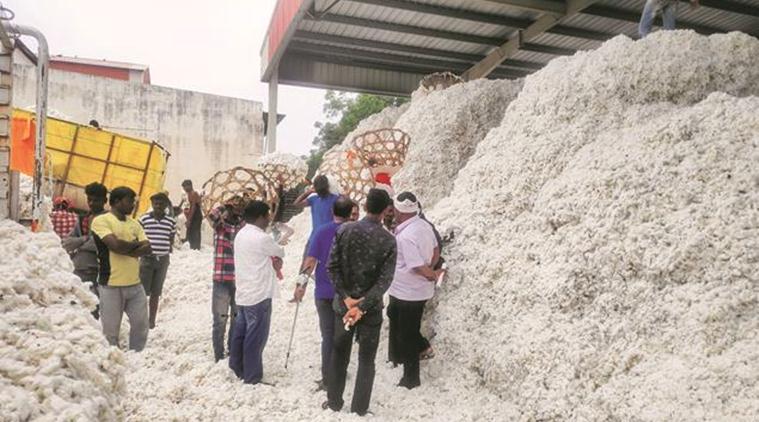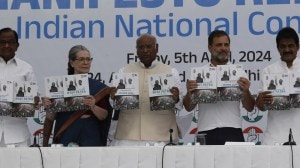- India
- International
Farm support: Minimum support price not on paper
Cotton growers are realising decent rates despite bumper crop this time, thanks to government procurement.
 Farmers at CCI’s procurement centre at Jalna. (Express photo: Parthasarathi Biswas)
Farmers at CCI’s procurement centre at Jalna. (Express photo: Parthasarathi Biswas)
In early-November, when Satyakumar Kolhe went to sell 18 out of his total 35 quintals produce of kapas (raw un-ginned cotton) at the Ambad wholesale market in Jalna district, the traders there quoted an average price of Rs 4,500 per quintal. The 45-year-old from Guru Pimpari village of Jalna’s Ghansawangi taluka, who grew the fibre crop on his entire four-acre land, decided to hold back.
“It didn’t make sense to sell at Rs 4,500, when the government’s minimum support price (MSP) was Rs 5,500/quintal. So, I decided to wait till CCI (Cotton Corporation of India) started buying towards the last week of November,” says Kolhe, who eventually sold his crop in two tranches of 18 and 17 quintals on December 18 and January 3, respectively at the procurement agency’s Bhokardan and Jalna purchase centres. He realised an average rate of Rs 5,330/quintal, as the moisture content in his produce was around 12%; the Rs 5,500 MSP required a level of only 8%.
“My decision to wait proved right. Since I had sold, even the traders at Ambad are offering Rs 5,100 now,” adds a bemused Kolhe.
The current cotton marketing season from October began badly for growers, due to a higher projected crop and weak export demand. The Mumbai-based industry body Cotton Association of India (CAI) has pegged the country’s production in 2019-20 at 354.50 lakh bales (of 170 kg each of lint fibre), compared to the previous year’s 312 lakh bales.
The average price of kapas (which contains 33-34% lint, with the balance accounted for by seed) in Maharashtra’s mandis was Rs 4,629.14 per quintal in October and Rs 4,830.79 in November. However, the rates improved to Rs 5,240.14 in December. Kapas is at present wholesaling at Rs 5,100-5,200 per quintal. Traders and ginners are admitting that prices will not fall from these levels for the rest of the season. CAI has estimated market arrivals as on December 31 at 125.89 lakh bales, which is just over 35% of this year’s total crop size.

The price recovery is being attributed partly to the positive market sentiment from news of receding trade tension between the US and China. Since August-end, the benchmark Cotlook A Index price has edged up from a low of 69.3 cents per pound to the current 78.75 cents level. Secondly, prices of cotton seed — whose oil is used for cooking and the leftover cake after extraction goes as animal feed — are looking good because of a poor soyabean crop, which suffered damage from excess rains. Washed cottonseed oil is currently trading at roughly Rs 90 per kg, up Rs 20 from a year ago — in line with the trend for all domestic as well as imported edible oils.
But the real factor behind price recovery has been CCI, which, together with other government agencies, had bought about 35 lakh bales or nearly 28% of the cumulative market arrivals till December 31. “CCI has allowed a maximum moisture limit of 12% for its purchases. As a result, the better quality of kapas has gone to it. That has, in turn, forced private traders to increase their rates so as to attract good quality produce,” explains Pradeep Shantilal Jain, founder president of the Khandesh Gin/Press Owners & Traders Development Association, a body of cotton ginners from the five northern Maharashtra districts of Jalgaon, Dhule, Nandurbar, Nashik and Ahmednagar.
“At present, 390 out of our 426 procurement centres across India are operational. We have ourselves bought 30.18 lakh bales as of January 1 (equivalent to 157.55 lakh quintals of kapas) and released payments of Rs 8,500 crore to farmers. In 2018-19, we procured only 10 lakh bales, as the crop was lower and market prices mostly ruled above MSP. This year, we may end up buying 50-60 lakh quintals,” P Alli Rani, chairman-cum-managing director of CCI, tells The Indian Express. Out of the 30.18 lakh bales, 16.97 lakh bales was procured from Telangana, with Maharashtra (4.64 lakh), Gujarat (1.74 lakh), Haryana (1.47 lakh), Punjab (1.42 lakh) and Rajasthan (1.21 lakh) being the other major contributors.
In order to sell his crop to CCI, Kolhe had to register a day in advance with the agriculture produce market committee mandis at Ambad and Jalna. The registration required him to submit relevant documents such as his “7/12” land record extract, bank account details and Aadhaar identification number. He could, then, bring his crop to the mandi, where it was first weighed before being taken to the nearby purchase centre having a ginning-and-pressing unit taken on lease by CCI. At these units, the seed is separated from the lint, which is pressed into bales.
“We make payments directly into the farmers’ bank accounts within 72 hours of sale,” claims S K Das, general manager of CCI at Aurangabad. Kolhe concurs: “Neither I nor other farmers have any complaints. Unlike other government agencies, they (CCI) don’t take long for registration and buying. Payment is also on time”. Das credits that to CCI operating more number of centres and also undertaking pre-harvest field surveys. It enables better planning than what is done by agencies engaged in procurement of pulses or oilseeds.
Alli Rani is confident that CCI will have no problem with disposal of the huge stocks accumulating in its godowns. “Once the season ends, we are the ones who will have all the good quality cotton. Why should this get sold at a loss? We can, if necessary, even export,” she points out.
Apr 25: Latest News
- 01
- 02
- 03
- 04
- 05








































